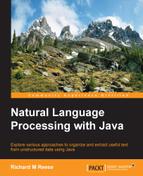With sentiment analysis, we are concerned with who holds what type of feeling about a specific product or topic. This can tell us that citizens of a particular city hold positive or negative feelings about the performance of a sports team. They may hold a different sentiment about the team's performance versus its management.
It can be useful to automatically determine the sentiment for aspects, or attributes, of a product and then display the results in some meaningful manner. This is illustrated using a review of the 2014 Camry from Kelly Blue Book (http://www.kbb.com/toyota/camry/2014-toyota-camry/?r=471659652516861060), as shown in the following figure.
The attributes, such as Overall Rating and Value, are depicted both as a bar graph and as a numeric value. The calculation of these values can be performed automatically using sentiment analysis.
Sentiment analysis can be applied to a sentence, a clause, or an entire document. Sentiment analysis may be either positive or negative or it could be a rating using numeric values such as 1 through 10. More complex attitude types are possible.
Further complicating the process, within a single sentence or document, different sentiments could be expressed against different topics.

How do we know which words have which types of sentiment? This question can be answered using sentiment lexicons. In this context, lexicons are dictionaries that contain the sentiment meanings of different words. The General Inquirer (http://www.wjh.harvard.edu/~inquirer/) is one such lexicon. It contains 1,915 words that are considered to be positive. It also contains a list for words denoting other attributes such as pain, pleasure, strong, and motivation. There are other lexicons such as the MPQA Subjectivity Cues Lexicon (http://mpqa.cs.pitt.edu/).
At times it may be desirable to build a lexicon. This is typically done using semi-supervised learning where a few labelled examples or rules are used to bootstrap the lexicon building process. This is useful when the domain of the lexicon being used does not match the domain of the problem area we are working on very well.
Not only are we interested in obtaining a positive or negative sentiment, we are interested in determining the attributes, sometimes called the target, of the sentiment. Consider the following example:
"The ride was very rough but the attendants did an excellent job of making us comfortable."
The sentence contains two sentiments: roughness and comfortable. The first was negative and the second was positive. The target, or attribute, of the positive sentiment was the job and the target of the negative sentiment was the ride.
